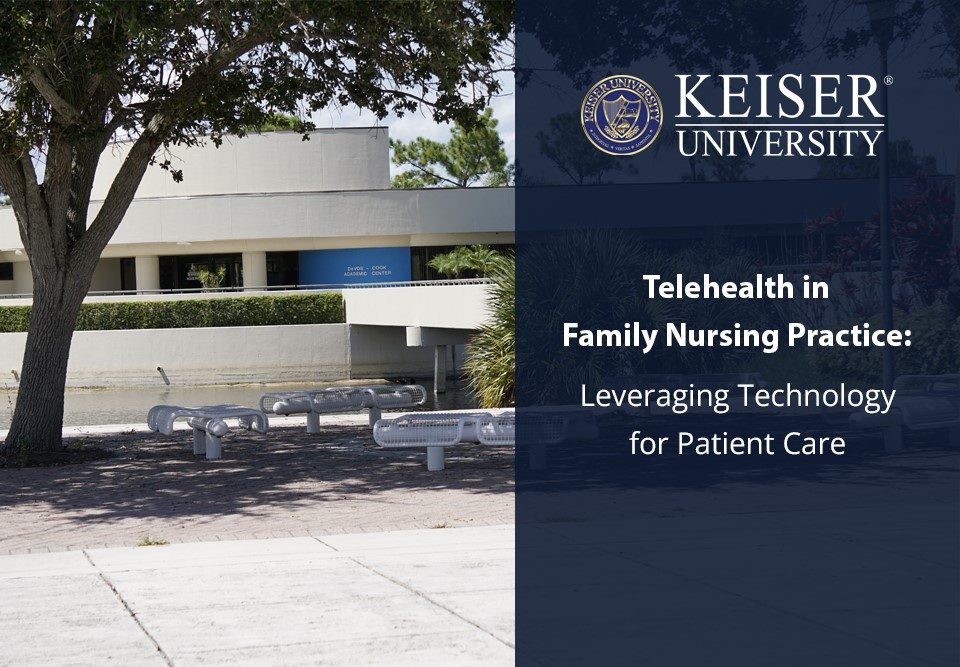As technology has continued to reshape and redefine our lives over the past several decades, it became clear to healthcare professionals that telehealth services would become vitally important in the digital era. However, it took a global pandemic to expedite the transition from traditional healthcare services to virtual medicine.
Today, telehealth in nursing practice is becoming increasingly common, and nurses interested in pursuing a career as a telehealth FNP and WHNP (Women’s Health Nurse Practitioner) should work to understand the impact of telehealth in nursing and in the medical field as a whole.
The Rise of Telehealth
Telehealth technology has been available for years, but it was not until the COVID-19 pandemic that telehealth services became the norm. During the initial phase of the pandemic, when many healthcare facilities were focused entirely on fighting the novel virus, most standard healthcare appointments had to be conducted virtually. Even in the aftermath of the pandemic, several patients continue to prefer telehealth services, highlighting the importance of telehealth in nursing.
Evolution of Telehealth Technology
As demand for telehealth services rose swiftly, there were rapid advances in telehealth technology. Today, patients can rely on a wide range of telehealth technology to receive comprehensive, personalized care from healthcare providers, including nurses.
Growth in Telehealth Adoption
According to the U.S. Department of Health and Human Services, telehealth services peaked during the pandemic, but today, telehealth reliance remains higher than it was prior to the pandemic. In 2022, survey results showed that 22 percent of U.S. adults had relied on telehealth services within a four-week period.
Regulatory Changes Supporting Telehealth
To ensure that patients are receiving reliable and secure healthcare services from telehealth providers, there have been regulatory changes to support and improve telehealth services. There are policies in place that improve telehealth security, protect patient privacy, limit prescribing controlled substances and maintain license requirements for practitioners.
Benefits of Telehealth in Family Nursing
Nurses’ role in telehealth is particularly crucial because nurses often serve as the point of contact during telehealth services. Within family nursing, telehealth is particularly beneficial because it offers:
Increased Accessibility
Telehealth appointments are more accessible, allowing patients to connect to family nurse practitioners and other providers, even if they are not within proximity of the healthcare facility.
Convenience for Patients
Many patients find telehealth appointments to be more convenient because they do not have to account for time to travel to the office for the visit or time to wait for the provider to arrive for their appointment. It is often easier to schedule telehealth appointments around existing obligations, such as work or childcare.
Cost-Effectiveness
Telehealth appointments are an affordable alternative to traditional, in-person appointments, and the rise in telehealth may help reduce overall healthcare costs in a country burdened by a complex and expensive healthcare system.
Improved Patient Outcomes
Family nurse practitioners may be able to improve patient outcomes through telehealth because they can provide personalized care in a safe, secure and distraction-free setting.
Enhanced Chronic Disease Management
Remote monitoring plays a key role in telehealth services, which is particularly beneficial for chronic disease management. Nurses can continue collecting data and monitoring their patients, even when they are not physically in the office, allowing them to better understand their patient’s condition and unique needs.
Key Technologies in Telehealth
As telehealth in nursing continues to grow and evolve, there will always be new technologies that will redefine the services that patients receive. These are some of the key technologies that are currently enabling nurses to provide expert care remotely:
Video Conferencing
Video conferencing tools allow patients to connect with providers in a secure and private way, giving them the opportunity to receive personalized care and treatment remotely. Video conferencing became a key component of telehealth services during the COVID-19 pandemic, when extreme social distancing restrictions were in place.
Remote Patient Monitoring
Remote monitoring, made possible by wearable healthcare technology and other devices, allows nurses and healthcare providers to continue to track patient data and monitor their well-being. Remote monitoring is essential to improving patient outcomes through telehealth services.
Mobile Health Apps
Mobile apps, such as those provided by healthcare organizations or third parties, allow patients and providers to stay connected to one another in a way that is both convenient and accessible. Mobile health apps allow users to track and record healthcare data, receive healthcare reports, contact their providers and more.
Electronic Health Records (EHRs)
Electronic health records (EHRs) are a vital part of telehealth services in the 21st century. These records allow providers to share vital health data and information with patients, and they also allow providers to collaborate better across specialties. For instance, a family nurse practitioner can easily share a patient’s EHRs with their cardiac care team, ensuring that all providers can work together to formulate a comprehensive care plan.
Wearable Devices
Wearable devices, such as fitness trackers or heart monitors, allow patients to better understand their own vital health signs as well as give providers better insight into the health and well-being of their patients. Wearable devices can record data and store it on the cloud, giving both providers and patients access to this critical data.
Applications of Telehealth in Family Nursing
Showcasing the nurses’ role in telehealth, there are numerous applications of telehealth in family nursing that benefit both patients and providers:
Routine Check-Ups
Patients who do not have any major concerns or who are not at risk of complications may be able to complete their routine check-ups via a virtual appointment. Remote routine check-ups can help save time, improve efficiency and reduce the cost of healthcare.
Chronic Disease Management
Patients suffering from a chronic disease are often burdened by excessive healthcare appointments. Through telehealth services, many of these follow-up appointments can be done remotely, making the process of chronic disease management easier for the patient.
Mental Health Services
By offering remote mental health services, family nurse practitioners can quickly work, while considering busy schedules, with patients who may be in need of emergency care. This ensures timely interventions that can be critical in preventing more severe outcomes.
Pediatric Care
For parents with young children, healthcare appointments can be stressful and overwhelming. Infants and toddlers need more routine check-ups than older children, and children of all ages tend to get sick frequently. Virtual appointments are much easier for parents to manage, allowing providers to offer enhanced pediatric care and improved outcomes.
Geriatric Care
Similar to pediatric care, geriatric care can be difficult. Elderly patients may have mobility limitations, or they may not be able to secure transportation to their appointments. Virtual appointments allow them to receive personalized care from the comfort of their own home.
Telehealth Best Practices for Family Nurses
As the impact of telehealth in nursing becomes clear, aspiring family nurse practitioners will want to focus on the best telehealth practices, which include:
Establishing Clear Communication
Clear and effective communication is critical, particularly in a virtual environment where the patient may not be able to rely as heavily on body language to infer meaning. A telehealth FNP will need to focus on using clear and understandable language and will also need to confirm that the patient understands the diagnosis and treatment plan.
Ensuring Patient Privacy and Confidentiality
In a physical exam room, it is much easier to control privacy and confidentiality. Telehealth nurses should ensure that patients are logging into their appointments in a safe and secure area, and they should remind them to select a private spot to take the video conference call.
Providing Technical Support for Patients
Given the fact that telehealth relies heavily on advanced technology, telehealth nurses often double as IT technicians. Nurses should be proficient in all telehealth technology, and they should feel comfortable enough with this technology that they can help patients navigate it as well. As a result, ongoing training and professional development is critical if you plan to be a telehealth FNP.
Continuously Updating Telehealth Skills
The demand for telehealth services is expected to continue to rise, and there is more advanced technology on the horizon that will reshape the industry. Telehealth nurses will be responsible for continuously updating their telehealth skills to provide patients with safe, secure and effective care.
Integrating Telehealth Into Existing Workflows
Nurses must be able to work with providers and other staff members to integrate telehealth services into the traditional workflow. When done right, telehealth services can help streamline operations at a healthcare facility, ultimately improving patient satisfaction ratings, patient outcomes and staff morale.
Challenges and Solutions in Telehealth
In many ways, telehealth has revolutionized the healthcare industry, helping to offset the burden that has been placed on an incredibly complex system. However, there are still challenges in telehealth that must be addressed, such as:
Technological Barriers
While telehealth is inherently more accessible than traditional medical care, there are still technological barriers that need to be addressed. Not all patients have access to high-end technology, and there are many patients who lack the technological skills needed to take advantage of telehealth services. Telehealth providers need to actively work to bridge the technology gap and improve digital literacy in their own communities.
Insurance and Reimbursement Issues
While telehealth has become more common, some insurance providers will not provide the same coverage for telehealth services. Healthcare providers and insurance companies need to collaborate to address ongoing insurance and reimbursement issues.
Licensure and Regulatory Hurdles
There continue to be licensure and regulatory hurdles for telehealth providers, with many having to monitor regulatory changes closely to ensure that they remain in compliance with the strict privacy regulations in place.
Patient Engagement and Compliance
Sometimes, it can be difficult for telehealth providers to keep patients engaged and ensure that they are complying with their treatment plans. Telehealth nurses should continue to leverage new and innovative technology to meet patients where they are at and improve overall engagement levels.
Discover the Importance of Telehealth in Nursing at Keiser University Graduate School
As the impact of telehealth in nursing becomes clear, aspiring family nurse practitioners will want to select a program that will emphasize the technological and practical skills needed to deliver virtual healthcare services. At Keiser University Graduate School, we offer a Master of Science in Nursing — Family Nurse Practitioner program that explores telehealth in nursing and equips students with the advanced nursing skills needed to pursue a career as an FNP.
Request more information about our graduate degree programs today.






 The instructors at Keiser University impacted my life. They believed in my ability to become a great graphic designer, regardless of how I felt about my skills. KU helped to prepare me for the real world and got me to where I am today.
The instructors at Keiser University impacted my life. They believed in my ability to become a great graphic designer, regardless of how I felt about my skills. KU helped to prepare me for the real world and got me to where I am today.
